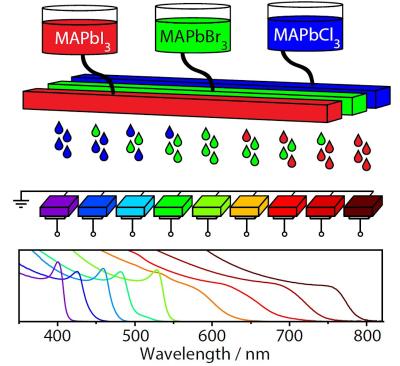Researchers from Innovation Lab HySPRINT at Helmholtz-Zentrum Berlin (HZB) and Humboldt Universität zu Berlin (HU) have used an advanced inkjet printing technique to produce a large range of photodetector devices based on a hybrid perovskite semiconductor.

By mixing three inks, the researchers were able to precisely tune the semiconductor properties during the printing process. Inkjet printing is already an established fabrication method, allowing fast and cheap solution processing. Extending the inkjet capabilities from large area coating towards combinatorial material synthesis could open the door to new possibilities for the fabrication of different kinds of electronic components in a single printing step.
The fabrication of electronic components with metal halide perovskites is appealing, as it is possible from solution, i.e. from an ink. Commercially available salts are dissolved in a solvent and then deposited on a substrate. The group around Prof. Emil List-Kratochvil, head of a joint research group at HZB and HU, focusses on building these types of devices using advanced fabrication methods such as inkjet printing. The printer spreads the ink on a substrate and, after drying, a thin semiconductor film forms. Combining multiple steps with different materials allows to produce solar cells, LEDs or photodetectors within minutes.
Researchers at HZB have already used inkjet printing to fabricate solar cells and LEDs made from perovskites. The inkjet capabilities were further expanded in 2020, when the group of Dr. Eva Unger first used a combinatorial approach to inkjet printing, to print different perovskite compositions in search of a better solar cell material.
Now, in this current work, the team around Prof. Emil List-Kratochvil found an exciting application for a large perovskite series within wavelength-selective photodetector devices. 'Combinatorial inkjet printing cannot only be used to screen different compositions of materials for solar cell materials,' he explains, 'but also enables us to fabricate multiple, separate devices in a single printing step.'
Looking towards an industrial process, this would enable large scale production of multiple electronic devices. Combined with printed electronic circuits, the photodetectors would form a simple spectrometer: paper thin, printed on any surface, potentially flexible, without the need of a prism or grid to separate the incoming wavelengths.



